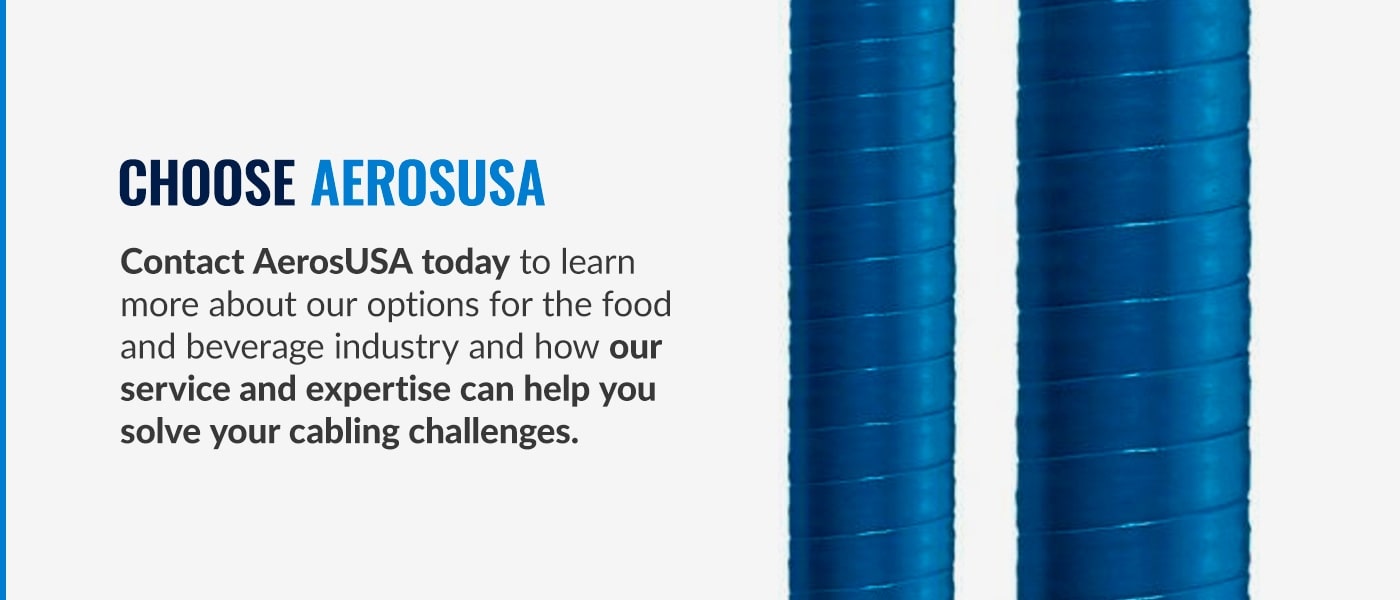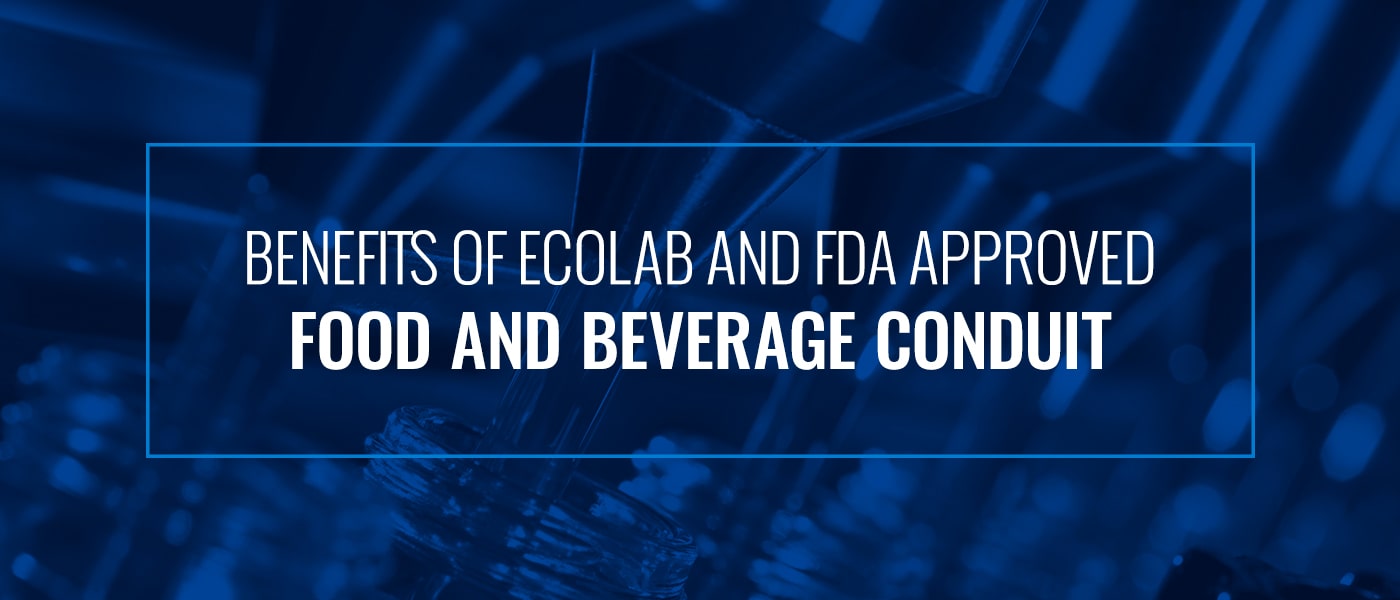
The food and beverage industry’s standards are some of the most demanding compared to other industries. While strict, these requirements are in place for a reason. According to estimates from the Centers for Disease Control and Prevention (CDC), 1 in 6 Americans get sick each year due to contaminated foods and beverages, and an average of 3,000 people die as a result of related injuries and illnesses. In total, the U.S. Department of Agriculture (USDA) estimates that foodborne illnesses cost over $15.6 billion each year between healthcare fees, lost production, recalls, regulatory fees and related costs. This doesn’t even include the unseen costs associated with the loss of consumer trust in a brand.
Sources of contamination can come from anywhere, and small sources can turn into significant problems if left unchecked. To protect against contamination, the food and beverage industry employs a range of specialized equipment for even the most peripheral systems. One significant type of specialized equipment is food and beverage electrical conduits. In this article, we’ll discuss food-grade electrical conduits, what they are, the standards for approval from EcoLab and the Food and Drug Administration (FDA) and how AerosUSA conduits can meet the challenge.
Table of Contents
Food and Beverage Conduits
Food and beverage conduit systems are essential components for processing systems within the industry. Conduits are designed to protect the electrical wiring systems and controls for processing equipment. With the rise of automation in conveyor systems, food and beverage processing facilities often employ thousands of power and data cables, all of which need to be protected from contamination. Conduits in food and beverage systems are designed to be liquid-tight, with strong structures and fitted seals to prevent liquids from entering the interior and compromising the cables inside.
While conduits serve the important purpose of protecting electrical wiring systems from contamination from the foods and beverages in the processing facility, conduits themselves can pose significant risks to the facility, namely the following:
- Contamination: Conduits and their fittings can become hosts for a range of bacteria and contaminants like listeria, salmonella and E. coli if not cleaned and maintained regularly. In a food and beverage industry production processing facility, these contaminants may fall from conduits into the processing line, contaminating the sterile environment.
- Electrical defects: Faulty conduits with gaps can store water from food processing or sterilization procedures, as well as corrosive elements. If these substances contact the wiring and eat away at protective coatings, it can result in electrical issues for the facility, potentially halting production until the problem is identified and fixed.
Both of these issues present a significant risk, as both contamination and electrical defects can take down a facility until the issue is resolved, costing the business thousands in lost productivity, repair fees and more. To mitigate risks and set industry standards, the FDA and other regulatory groups have set forth specific design guides for conduits.
Regulatory Requirements for Conduits in the Food and Beverage Industry
The food and beverage industry is subject to a range of regulations, approvals and best practices, specifically related to equipment and sanitation procedures. Conduits for the food and beverage industry are no different. While some industry equipment is only held to one or two agencies or standards, conduits must meet FDA standards and be tested and approved by trusted third-party testing sources like NSF and EcoLab. Below we’ll discuss the primary regulatory requirements that apply to conduits, as well as what it takes for conduits to meet NSF and EcoLab standards.
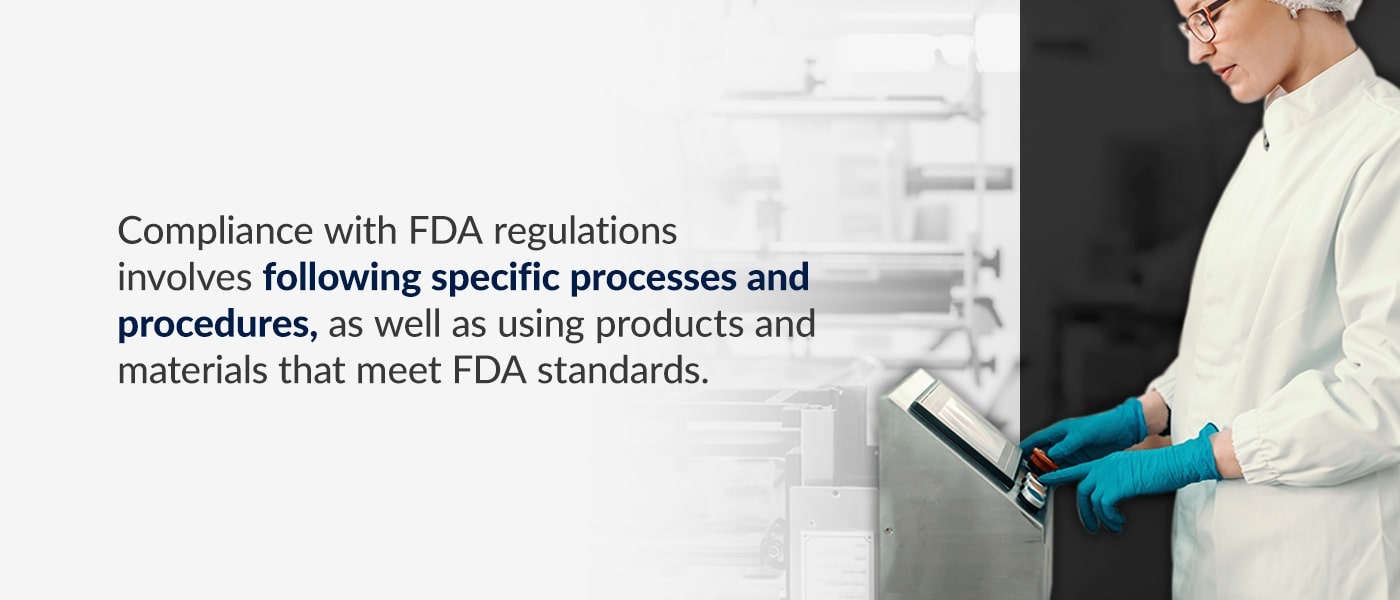
1. FDA Requirements for Conduits
The FDA is the primary regulatory agency to which the food and beverage industry must maintain compliance. Compliance with FDA regulations involves following specific processes and procedures, as well as using products and materials that meet FDA standards.
One of the main points to note regarding FDA compliance is that the agency does not approve cables or machine components in food and beverage applications itself. Rather, “FDA compliance” for conduits can be obtained through third-party testing per the Code of Federal Regulation (CFR) Title 21. The CFR codifies the general rules published in the Federal Register by agencies of the federal government, and Title 21 specifically pertains to rules from the FDA.
Per the rules laid out by CFR Title 21, conduits must meet the following minimum requirements:
- Sanitary: The materials of the conduit itself must be sanitary.
- Easy to clean: The material and geometry of the conduit must be easy to clean to FDA sanitation standards.
- Safe for food contact: While electrical conduits rarely have direct contact with food materials, the conduit material must be safe to contact foods and beverages if it is in a contact or splash zone.
One area of particular concern on the materials side is leaching, which is when a material breaks down and dissolves particulates in the presence of specific environmental conditions. This is a prevalent issue for many materials like certain metals, rubbers, plastics, coatings and paints, which may leach contaminants when exposed to heat, moisture or other conditions. Of particular concern is flame retardancy, which often requires chemical coatings that leach out over time when exposed to water, heat or air and may contaminate the food processing area. For this reason, all cable conduits in a contact or splash zone must use approved flame retardant or self-extinguishing materials.
2. NSF Requirements for Conduits
In addition to food safety requirements, conduits must also meet electrical requirements from the National Electric Code (NEC) and the Occupational Safety and Health Administration (OSHA), as well as UL standards. NSF International is a Nationally Recognized Testing Laboratory (NRTL) for electrical products accredited by OSHA. NSF can test and certify electrical conduits, including food-grade conduits, against industry standards such as:
- UL 651
- CSA C22.2 No. 211.1
- CSA C22.2 No. 211.2
- NEMA TC 2
NSF tests electrical conduits to applicable standards and performs audits of the production facility to determine eligibility for approval. The primary focus of these tests is on electrical security and safety, which are as essential for food and beverage conduits as food safety and sanitation.
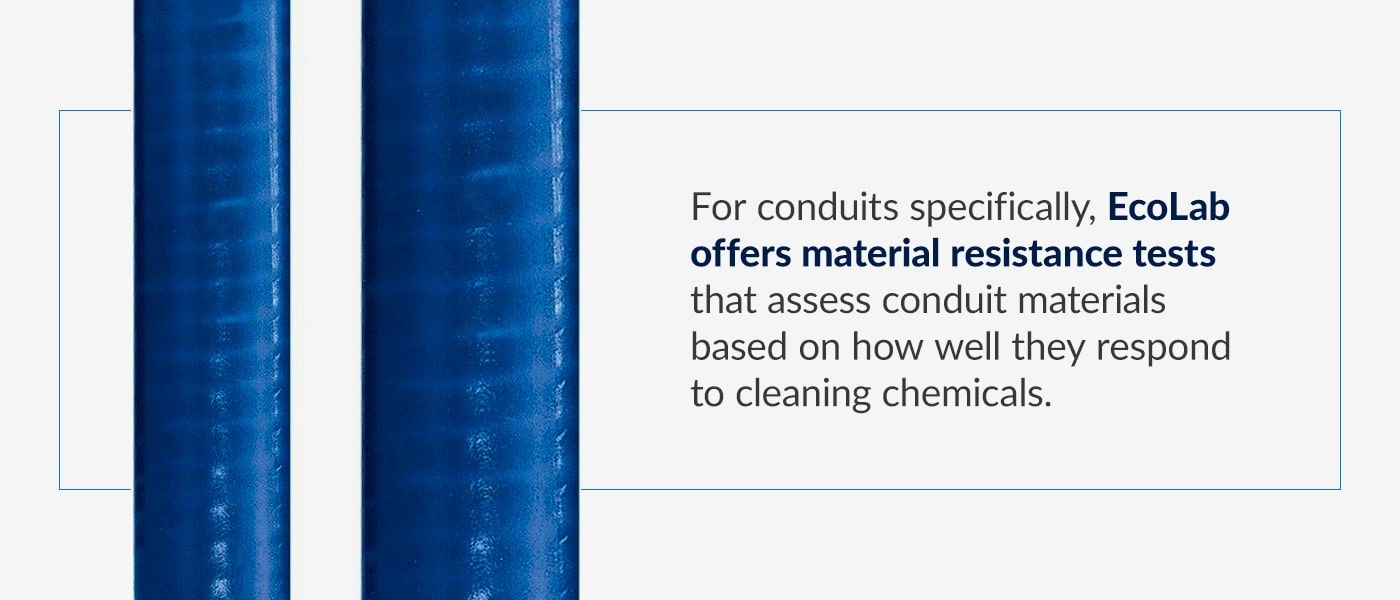
3. EcoLab Requirements for Conduits
To stay ahead of future demand and requirements, conduit and cable manufacturers often get their conduits tested and approved by companies that specialize in the type of sanitation used in food and beverage production facilities. One such company is EcoLab Inc., an industry leader in professional disinfection for several industries, including the food and beverage industry. For conduits specifically, EcoLab offers material resistance tests that assess conduit materials based on how well they respond to cleaning chemicals.
The ability of a conduit to hold up against corrosive disinfectants is a significant factor. Bacteria can adapt and survive on a range of surfaces, which is why structured and thorough cleaning procedures are a necessity in the food and beverage industry. Wash-down procedures usually involve cleaning processing equipment with high powered jets, steam, hot water or chemical agents up to five times a day. Conduits help protect wiring from these washes, but the repeated cleaning can negatively impact the integrity of conduit systems within the wash-down area.
EcoLab food and beverage tests assess conduits for their ability to fend off corrosion. These tests utilize a range of cleaning and disinfecting agents used in the food and beverage industry. Common cleaning agents used in testing include chloride, sulfuric acid, hydrochloric acid, hydrofluoric acid, chlorine and other disinfectants. Testing usually involves submerging materials in these substances for several days before assessing them through visual and mechanical inspection. Successful materials do not display cracks, swelling or significant mechanical changes.
ADVANTAGES OF ECOLAB CERTIFIED CONDUITS
Certified Ecolab food and beverage conduits offer various advantages over standard conduits, including hygienic design, chemical resistance, durability, compliance with the law and cost-effectiveness. When you choose Ecolab-certified conduits in your production processes, you will help to ensure your food and beverage company’s products are safe, high-quality and compliant with FDA approval for food.
Easy to Clean
These conduits are easy to clean, which minimizes the risk of bacterial growth. They have smooth surfaces and minimal crevices, so there are fewer places for bacteria to grow and hide. This helps ensure food and beverage products remain safe and free from contamination.
Chemical Resistant
Another Ecolab benefit of certified conduits is that they are resistant to a wide range of chemicals, including cleaning agents and disinfectants. This means they can be used in environments where harsh chemicals are commonly used without risking damage or degradation.
Durable
They are also durable as they’re made using high-quality materials, designed to handle the harsh conditions of food and beverage production environments. They’re resistant to extreme temperatures, impact and abrasions, so they can be counted on to last for many years.
Making use of Ecolab-certified conduits can help your company comply with a wide range of regulations and standards including those related to food safety, hygiene and environmental protection. This can help reduce the risk of fines, legal action and damage to your company’s reputation.
Ecolab-certified conduits do tend to have a higher upfront cost, but they offer excellent value over the long term. Their durability and resistance to damage mean they require less frequent replacement than standard conduits, which can help to reduce maintenance and repair costs over time.
Wherever food processing occurs, strict hygiene is an integral component. Compliance with hygiene regulations requires processing plants to be treated with powerful disinfectants and cleaning agents. Conduits are exposed to heavy loads of strong chemicals, so they must be durable enough to handle these.
Trusted Quality and Excellence From Ecolab
Ecolab is a world leader in the industrial cleaning and hygiene sectors, specifically for disinfecting and cleaning processing equipment in the food and beverage industry. They provide a complete range of disinfectants and cleaners for factory equipment.
They also offer testing and certification services for cable manufacturers. The Ecolab certification means certified conduits are resistant to certain chemicals used to clean machines in the food processing machinery of production plants.
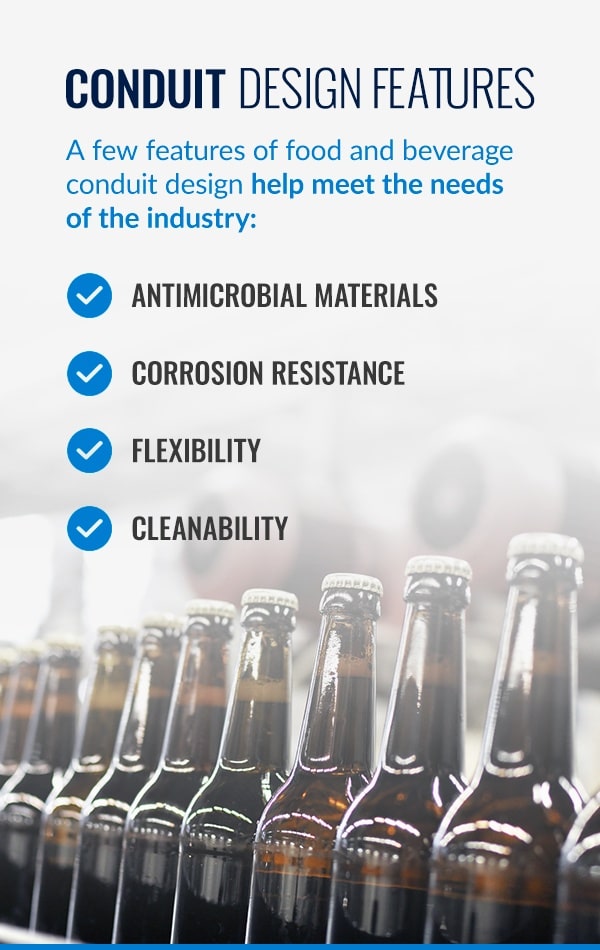
Conduit Design Features
Many protective cable conduit systems are available to meet the regulatory and practical needs of food and beverage facilities. Below are just a few features of food and beverage conduit design help meet the needs of the industry:
- Antimicrobial materials: Many conduits are designed with antimicrobial or microbe-resistant materials. These include naturally microbe-resistant materials as well as materials augmented with antimicrobial properties.
- Corrosion resistance: Conduits are made with corrosion-resistant materials to protect against the barrage of cleaning materials used in sanitation processes, as well as acidic foods and beverages. They are also designed to hold up against heat, moisture, evaporation and other environmental factors within food and beverage plants that can contribute to corrosion. Some examples of corrosion-resistant materials include stainless steel, aluminum, alloys, coated materials and specialty non-metallic materials.
- Flexibility: Many conduits are used in moving parts such as automated pick and place arms and conveyor systems or are moved around as processing plants are rearranged. In applications like these, flexible conduits are often used, which are specifically designed to maintain integrity despite repetitive movements or tight bending radii. Flexible metallic and flexible non-metallic conduits are available to meet varying needs.
- Cleanability: Perhaps most importantly, conduits are often made with shapes that make for quick and easy cleaning. Food particles, bacteria and other contaminants can easily get trapped in small spaces like crevices and cracks. The more of these crevices and cracks there are, the harder the surface is to clean. Over time, this can result in significant bacterial growth, leading to contamination. The geometry of conduits is specifically designed to shed contaminants quickly, and crevices are minimized or tucked away from contact and splash zones to minimize collecting food residues.
Conduits come in several types and materials to meet the specific needs of a food and beverage facility. If you’re looking for a conduit system for your facility that features all of the above and more, AerosUSA has options for you.
The Benefits of AerosUSA Conduits
The food and beverage industry has demanding standards to ensure that food is safe to eat. Conduits for electrical cables are particularly specialized for this industry to meet all the industry’s regulatory and practical demands. With FDA, NSF and EcoLab approved conduits, you can rest easy knowing that your conduits meet or exceed standards for the industry. If you’re looking for EcoLab and FDA approved nerve conduits, AerosUSA has options for you.
AerosUSA offers microbe-resistant conduits for the food and beverage industry. Made with food-safe, sturdy materials and high-efficiency plastic seals, these conduits are easy to clean and effectively reduce contamination. In addition, our food-grade conduits are resistant to the detergents and cleaning processes commonly applied in the food and beverage industry.
Our food and beverage conduits include two lines:
- AIRFLEX-GRS-FOOD: The AIRFLEX-GRS-FOOD conduit is a protective all-plastic conduit that features plain inside and outside surfaces so it’s easy to draw cables through it and easy to clean outside surfaces. The conduit’s helix design is unplasticized but still flexible, and the material is microbe-resistant as well as air- and liquid-tight. Resistant to a range of oils and acids, this polyvinyl chloride (PVC) conduit can handle temperatures from -13°F to 122°F. This conduit is available in four sizes from 1/2 inch to 1 1/4 inch.
- LIQUID-TIGHT-FOOD: The LIQUID-TIGHT-FOOD conduit is a protective metal conduit featuring a galvanized steel inner core and polyurethane (PU) sheathing for maximum temperature stability and protection as well as quick cleaning. Extremely liquid-tight and resistant to acid and petrol, this conduit is flexible, UV resistant and self-extinguishing. It can handle temperatures from -40°F to 176°F and is available in 1/2-inch, 3/4-inch, 1-inch and 1 1/4-inch diameters.
Both conduit types pair with our food-grade fittings to make a complete system approved for food and beverage applications. AerosUSA is the premier supplier of food-grade conduits, with all products manufactured to the highest quality. Best of all, our conduits carry certifications and recognition from the FDA, EcoLab and NSF.
CHOOSE AEROSUSA FOR FOOD & BEVERAGE GRADE CABLE PROTECTION
AerosUSA was founded by veterans of the cable protection industry with one goal in mind – to provide exemplary customer service. Today, AerosUSA delivers innovative, cutting-edge technology to our customers across a range of industries from the food and beverage industry to mining, robotics and rail companies. With years of expertise in a wide range of industries and agile customer service, we are committed to delivering value to your company.
Contact AerosUSA today to learn more about our options for the food and beverage industry and how our service and expertise can help you solve your cabling challenges.

